Background
The APSL Program and Asian SignBank
Deaf and Hearing Collaboration
Benefits to Sign Language Research
Long-term Significance
Philosophical and Technical Frame
Acknowledgement
Background
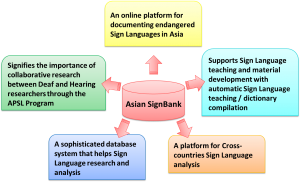 (Click to enlarge)
(Click to enlarge)
The Asian SignBank is an online database developed for sign language research. The idea, initiated by the Centre for Sign Linguistics and Deaf Studies, was realized by the joint effort of the Department of Linguistics and Modern Languages, CUHK and the Department of Systems Engineering and Engineering Management, CUHK. Tiding the efforts from two ends of research disciplines, the Asian SignBank was constructed on the philosophical ground of Sign Linguistics and assembled through the technical implementation of Systems Engineering.
The Asian SignBank is not a Sign writing system design to reflect representation of the sign language system which has an effect of promoting sign language literacy. The Asian SignBank is an online database developed with a significant research purpose which is to facilitate componential analysis and storage of sign entries.
The application side yet is to facilitate sign language teaching and materials development, as well as Asian Sign Language research. The Asian SignBank targets on documenting sign language data from Asia Pacific Region Researchers from the Asian countries participating in the research and training program contribute to data input, the foundation of the Asian SignBank.
The APSL Program and Asian SignBank
The Asian SignBank serves as a central reservoir of research data obtained in the APSL Training Program (http://www.cslds.org/apsl).
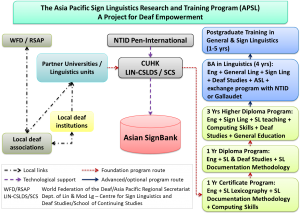 (Click to enlarge)
(Click to enlarge)
Deaf and Hearing Collaboration
The Asian SignBank and its related functions have high pedagogical and research value for sign language teachers, interpreters, social workers and sign language researchers. More important still, the Asian SignBank signifies the importance of collaborative research between the Deaf and Hearing researchers through the APSL Program, which aims to provide Sign Linguistics training to Deaf researchers, for them to contribute to the construction of the Asian SignBank and to design teaching materials and dictionaries to support the Sign Language research and training development of their countries.

Deaf and hearing researchers are discussing the features of signs

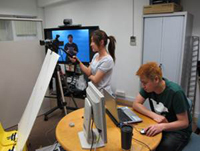
Hong Kong deaf and hearing researchers are shooting video of signs
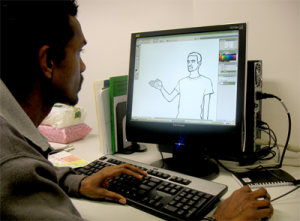

Sri Lankan deaf researchers discuss and manipulate photos taken for the Asian SignBank
Benefits to Sign Language Research
Asian SignBank can facilitate Sign Linguistics research in the following ways:
-
Provide a platform for side-by-side viewing of signing videos and linguistics informations.
In the old days, sign language researchers had to rely on hard copies of images to analyze the linguistic features of signs. However, the movement properties cannot be represented in detail in photos. In addition, Asian SignBank is capable of storing a wide range of linguistic information of a sign. For example,
- Glosses of signs in their native language and English, to facilitate both local and international access of information,
- Individual glosses for each component in compound signs,
- Examples which make use of that sign,
- Related signs which show variation of the signs in Deaf community,
- Detailed phonetic information which includes inherent features (i.e. static features of a sign, like the handshape, place of articulation, body part, palm orientation, handparts, etc.) and prosodic features (i.e. dynamic features of a sign, like path and shape, setting, orientation, aperture and handshape changes, trilled movements, etc.)
-
Provide a querying system which helps to manipulate data into meaningful information
Other than providing a storage and viewing platform for the linguistic properties of signs, a remarkable feature of the Asian SignBank is that it allows a searching strategy of the signs according to any piece of information one may know about them, from the glosses to the most detailed phonetic information. It does not only allow searching by a feature but also by a conditioned combination of features. For instance, a user can search for a sign with handshape plus a location feature (e.g. 5-handshape + articulated on the shoulder). Virtually the system allows unlimited number of searching conditions. This searching strategy is not only used as sign retrieval purpose, but it also serves a descriptive statistical purpose such as frequency of occurrence of particular features of signs. When the system extends to include other sign languages in Asia, the system will allow a cross-linguistic comparison of signs and their linguistic information. For example, it is interesting to know how many sign languages in Asia make use of an upright Y-handshape to refer to humans, animals or animate properties in general.
Long-term Significance
- Allows researchers to document sign languages in a handy and expandable multimedia database system
- Allows researchers to query various Asian sign language data by virtually unlimited means
- Allows researchers to generate search outputs in formats that facilitate qualitative and quantitative analysis
- Allows sign language dictionary and glossary production in customized formats
- Allows sign language materials production that suit different teaching purposes
- Enhance publicity of Asian sign languages in the society, which is deemed essential to formal recognition of sign languages in the region
Philosophical and Technical Frame
The sign notation system used in the Asian SignBank is based on a feature analysis approach according to the prosodic model proposed by Brentari (1998).
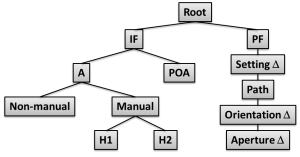 (Click to enlarge)
(Click to enlarge)
The Model was adopted with some modificationsm as shown below (click on each picture to see the enlarged image).
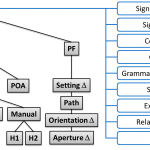
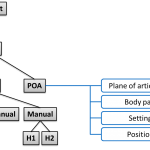
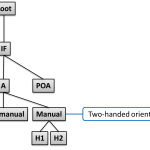
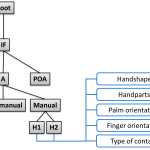
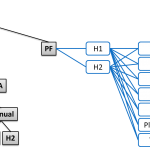
Acknowledgement

We would like to acknowledge the generous support of The Nippon Foundation in this research project, without which the hope of implementing deaf training in Sign Linguistics and developing a platform for documenting Asian sign languages would never be achieved. Our thanks also go to the Deaf and hearing researchers at this initial stage of development, namely Kenny Chu, Brenda Yu, Connie Lo, Zoe Li, Michael Choi, Jafi Lee, Felix Sze and Joe Mak, who assist in identifying linguistic information of the signs, serving as models for the photos and video recordings, as well as enhancing the photos with graphics.
 (Click to enlarge)
(Click to enlarge) (Click to enlarge)
(Click to enlarge)




 (Click to enlarge)
(Click to enlarge)




